Chapter 7 Structural Organisation in Animals
Class 11th Biology NCERT Book Solution
NCERT Solutions For Class 11 Biology Structural Organisation in Animals
NCRT TEXTBOOK QUESTIONS SOLVED
1. Answer in one word or one
line.
(i)
Give the common name of Periplaneta americana.
(ii) How many spermathecae are found in earthworm?
(iii) What is the position of ovaries
in cockroach?
(iv) How many segments are present in
the abdomen of cockroach?
(v) Where do you find Malpighian tubules?
Solution: (i)
Cockroach.
(ii) Four pairs.
(iii) In cockroach two large ovaries, lie
laterally in the 2nd – 6th abdominal segments’.
(iv) Abdomen of cockroach
consists of 10 segments.
(v) Malpighian tubules are present at the junction
of midgut and hindgut in cockroach.
2. What are the following and
where do you find them in animal body?
(a) Chondrocytes
(b) Axons.
(c) Ciliated
epithelium
Solution: (a)
Chondrocytes – Chondrocytes are the only cells found in cartilage. They are
present in spaces called lacunae and they produce and maintain the matrix of
cartilage. Bending ability of cartilage is due to chondrocytes. Cartilage is
present at tip of nose, pinna of ear, epiglottis etc.
(b) Axon – Axon is one
of the processes of neuron, which is the structural and functional unit of
nervous system. The part of cyton – n’here axon arises is axon hillock and axon
ends in group of branches called terminal arborizations. It conducts impulses
away from the cyton. Neurons (nerve cells)
are present in brain and spinal
cord.
(c) Ciliated epithelium – If the columnar or cuboidal cells bear cilia
on their free surface they are called ciliated epithelium. Their function is to
move particles or mucus in a specific direction over the epithelium. They are
mainly present in the inner surface of hollow organs like bronchioles and
Fallopian tube.
3. Draw a labelled diagram of
the reproductive organs of an earthworm.
Solution: 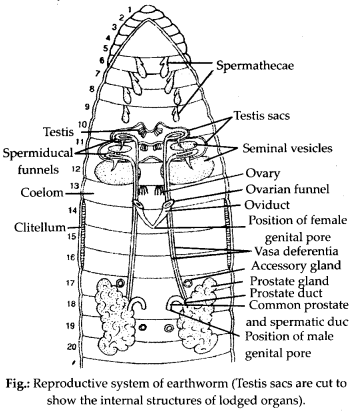
4. Answer the
following.
(i) What is the function of nephridia?
(ii) How many types of nephridia are found in earthworm based on their
location?
Solution: (i)
Nephridia are excretory organs of earthworm, which perform the function of
excretion and osmoregulation. Nephridia regulate the volume and composition of
the body fluids. A nephridium is a coiled tubular and microscopic structure
which starts out as a funnel that collects excess fluid from coelomic chamber.
The funnel connects with a tubular wastes through a pore to the surface in the
body wall or into the digestive tube.
(ii) In earthworm, nephridia are
present in all segments except the first two. There are three types of nephridia
on the basis of their location:
(a) Septal nephridia, present on both the
sides of intersegmental septa from segment 15 to the last that open into
intestine.
(b) Integumentary nephridia, attached to lining of the body wall
of segment 3 to the last that open on the body surface and
(c) Pharyngeal
nephridia, present as three paired tufts in the 4th, 5th and 6th
segments.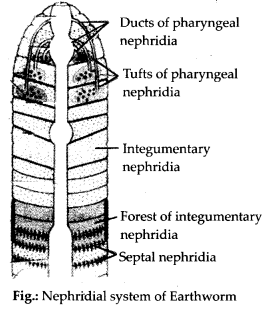
5. Draw a labelled diagram of
alimentary canal of a cockroach.
Solution: 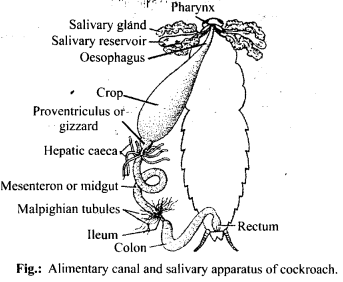
6. What are the cellular
components of blood?
Solution: Blood is a
fluid connective tissue. It is composed of plasma (fluid) and blood cells
(corpuscles). Cellular components of blood (blood corpuscles) constitute about
45% of blood volume.
Three types of blood cells are:
(i) Erythrocytes or
red blood cells: They are most abundant blood cells. Normal RBC count is 5-5.5
million/mm3 in males and 4.5-5 million/mm3 in females)
RBCs help in transport of gases and maintain blood pH.
(ii) Leucocytes or
white blood cells: The normal WBC count is 5000-6000/mm3 of blood.
They are involved in immune response of body and act as soldiers and
scavangers.
(iii) Thrombocytes or blood platelets: There are about 2,50,000
platelets/mm3 of blood. They are involved in blood clotting.
7. Distinguish between the
following:
(a) Prostomium and peristomium
(b) Septal nephridium and pharyngeal
Solution: (a)
Differences between prostomium and peristomium are
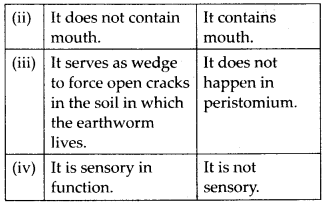
(b) Differences between septal and pharyngeal nephridia
are: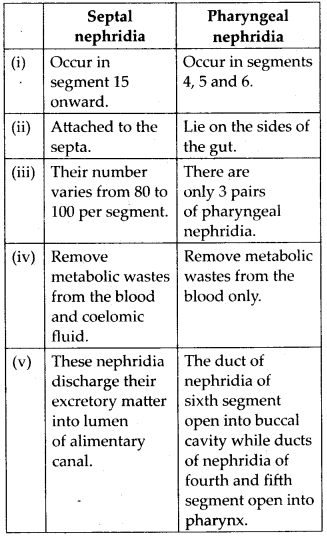
8. Mark the odd one in each
series.
(a)
Areolar tissue; blood; neuron; tendon
(b) RBC; WBC; platelets; cartilage
(c) Exocrine; endocrine; salivary gland; ligament
(d) Maxilla; mandible; labrum;
antennae
(e)
Protonema; mesothorax; metathorax; coxa.
Solution:
(a) Neuron: Areolar tissue, blood and tendon are connective tissues while neuron
is a part a nervous tissue.
(b) Cartilage: RBC, WBC and platelets are parts
of vascular connective tissue while cartilage is skeletal connective tissue.
(c) Ligament: Ligament is a connective tissue.
(d) Antennae: Maxilla,
mandible and labrum are mouth parts of cockroach while antennae are sense
organs.
(e) Protonema: Protonema is a filamentous juvenile stage in life
cycle of Bryophytes, while mesothorax, metathorax and coxa are appendages of
cockroach.
9. Match the terms in column I with those in column II.
|
Column I |
Column II |
| (a) Compound epithelium (b) Compound eye (c) Septal nephridia (d) Open circulatory system (e) Typhlosole (f) Osteocytes (g) Genitalia |
(i) Alimentry canal (ii) Cockroach (iii) Skin (iv) Mosaic vision (v) Earthworm (vi) Phallomere (vii) Bone |
Solution: (a) – (iii), (b) – (iv), (c) – (v), (d) – (ii), (e) – (i), (f) – (vii), (g) – (vi)
10. Mention briefly about the
circulatory system of earthworm.
Solution: Earthworm
possesses a closed type of blood vascular system, as the blood flows through
closed blood vessels. Blood is red in colour due to respiratory pigment
haemoglobin. Prominent blood vessels in earthworm includes dorsal, ventral, sub-
neural, lateral oesophageal and supra- oesophageal blood vessels. There are four
pairs of tubular hearts, provided with valves. The anterior two pairs of hearts,
known as lateral hearts lie in the 7th and 9th segments and connect the dorsal
blood vessel with the ventral blood vessel. They receive blood from the dorsal
blood vessel and convey it to the ventral blood vessel. The posterior two pairs
of hearts are called latero-oesophageal hearts and are situated in the 12th and
13th segments. The latero-oesophageal hearts apart from connecting the dorsal
and ventral blood vessels are also joined with the supra oesophageal blood
vessel. Latero-oesophageal hearts carry blood from the dorsal vessel and the
supra oesophageal vessel to the ventral blood vessel.Contractions keep blood
circulating in one direction. Blood glands are present in the 4th, 5th and 6lh
segments which produce blood cells and haemoglobin which is dissolved in blood
plasma. Blood cells are phagocytic in nature.
11. Describe various types of
epithelial tissues with the help of labelled diagrams.
Solution:
Epithelial tissue is a tissue made of one or more layers of compactly arranged
cells that covers external surface and internal free surface of body organs and
which is underlined by a basement membrane. The various types of epithelial
tissue along with the diagram are given below:
(i) Simple epithelium : It is
composed of single layer of cells which rest on basement membrane. Simple
epithelium generally occurs over secretory and absorptive surfaces and forms
lining of body cavities, ducts and tubes. Simple epithelium is of several
types.
(a) Squamous epithelium: It consists of single layer of flat cells,
tightly linked together and have centrally located oval or spherical nucleus. It
is also called pavement epithelium. It is found in walls of blood vessels, air
sacs of lungs, and lining of eye lens.
(b) Cuboidal epithelium: Cells of
cuboidal epithelium are as tall as wide, with centrally placed nucleus. Its main
functions are secretion and absorption. It lines sweat gland, thyroid follicles,
salivary glands. Brush bordered cuboidal epithelium, i.e., cells having
microvilli on their free surface lines proximal part of uriniferous tubule,
pancreatic duct, testis and ovary.
(c) Columnar epithelium: Cells are with
basally located nucleus. It helps in secretion and absorption. It occurs in
lining of intestine, stomach, gall bladder.
(d) Ciliated epithelium: Free
surface of columnar and cuboidal cells are covered with cilia. Cilia help in
moving fluids, particles, mucus, etc. in a specific direction. It occurs in the
inner surface of Fallopian tubules, nasal passage, bronchioles.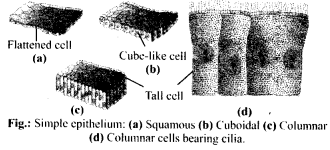
(e) Pseudostratified epithelium: It consists of single layer
of cells but some cells are shorter than others. Due to difference in size of
cells, the epithelium appears 2-3 layered. Pseudostratified columnar epithelium
occurs in urethra and parotid salivary gland. Pseudostratified columnar ciliated
epithelium (only larger cells ciliated) occurs in lining layer of nasal’
chambers, trachea and large bronchi. It helps in moving mucus and foreign
particles.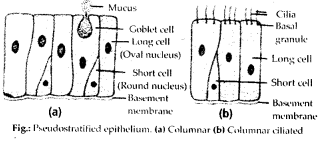
(ii) Compoundepithelium/stratifiedepithelium: It is
multilayered epithelium where cells of only the lowermost or basal layer are in
contact with basement membrane. It provides protection against mechanical and
chemical stresses and has limited role in secretion and absorption. It covers
dry surface of skin, moist surface of buccal cavity, pharynx, etc. Different
types of compound epithelium are:
(a) Stratified squamous epithelium: The
cells of outer layer are flattened and squamous while the inner layers are
cuboidal cells. It is of two types: Non- keratinised lining oesophagus, pharynx,
buccal cavity, cornea, vagina and anal canal and keratinised (comified): forming
epidermis of skin, hair, horn and nail.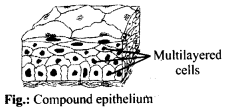
(b) Stratified cuboidal epithelium: The outer layer of
cuboidal cells and basal layer of columnar cells. It lines ducts of sweat
glands, large salivary and pancreatic ducts.
(c) Stratified columnar
epithelium: Both upper and basal layers are made of columnar cells, e.g.,
epiglottis covering, part of urethra.
(d) Stratified ciliated columnar
epithelium: Outer layer consists of ciliated columnar cells and basal layer of
columnar cells, e.g., larynx.
(iii) Transitional Epithelium: This is
stratified epithelium which contains cuboidal or columnar shaped cells, which
are thin and stretchable. No basement membrane is present as it would impede
stretchability. It lines the inner surface of renal calyces, urinary bladder,
ureter. Because of its t distribution, it is also called urothelium.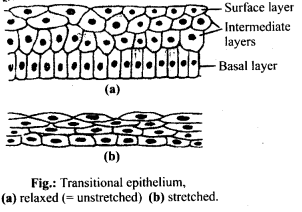
(iv) Glandular epithelium: It consists of specialised
epithelial cells which synthesise intracellular macromolecules (protein in
pancreas, lipids in adrenal glands, glycoprotein in salivary glands and all the
three in mammary glands) and pour out the same in the form of a useful fluid
secretion which is different from blood or any other extracellular fluid. Glands
can be unicellular or multicellular on the basis of number of cells.
(a)
Unicellular glands: Single-celled, e.g., goblet (mucous) cells of respiratory
tract and alimentary canal.
(b) Multicellular glands: Consist of cluster of
cells, e.g., Salivary glands.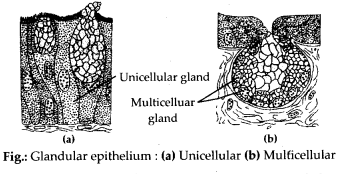
On the basis of presence or absence of duct glands can
be:
(a) Exocrine glands : These glands pour their secretion through a duct.
They secrete milk, saliva, mucus, earwax. e.g., goblet cells, salivary glands,
tear glands, gastric glands, intestinal glands.
(b) Endocrine glands: They
are ductless glands, which pour their secretions into blood or lymph for
reaching the target region. Their secretion is called hormone e.g., pituitary
gland, thyroid gland, parathyroid glands, adrenal glands.
(c) Heterocrine
glands: Both exocrine and endocrine, e.g., pancreas.
On basis of mode of
secretion glands can be:
(a) Merocrine: Secretion is discharged
through
diffusion, e g., goblet cells, sweat glands.
(b) Apocrine glands: Glandular
secretion accumulates in the terminal part of the cell which is pinched off,
e.g., mammary glands.
(c) Holocrine glands : The cell filled with secretory
product disintegrates during discharge of the product, e.g., sebaceous
gland.
(v) Modified epithelium : It is of following types:
(a) Germinal
epithelium (generally cuboidal, produces gametes), (b) Glandular epithelium
(columnar or cuboidal secretes chemicals and mucus), (c) Sensory epithelium or
neuroepithelium. Epithelial cells having sensory hair on free surface and
connected with nerve fibres on the other surface (generally columnar, receives
and conveys stimuli), e.g, nasal epithelium, taste buds, retina, sensory spots
of internal ear. (d) Pigmented epithelium – The cells possess melanin granules,
e.g, retinal layer in contact with choroid of eye.
12. Distinguish
between
(a)
Simple epithelium and compound epithelium.
(b) Cardiac muscle and striated muscle.
(c) Dense regular and dense irregular connective
tissues.
(d)
Adipose and blood tissue.
(e) Simple gland and compound gland.
Solution:
(a) Differences between simple and compound epithelium are as follows: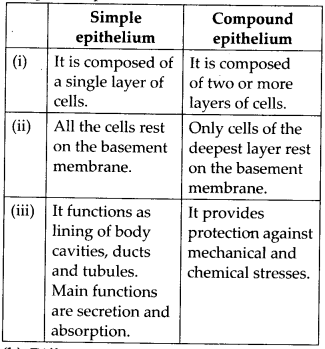
(b) Differences between cardiac and striated muscles are as
follows: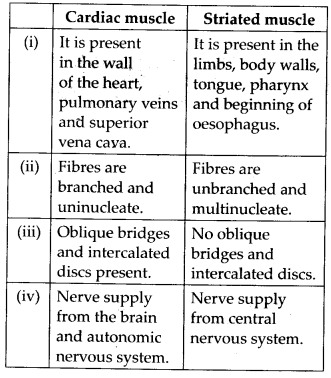
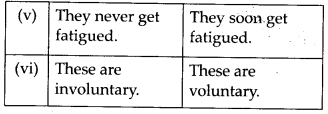
(c) Differences between dense regular and dense irregular
connective tissues are as follows: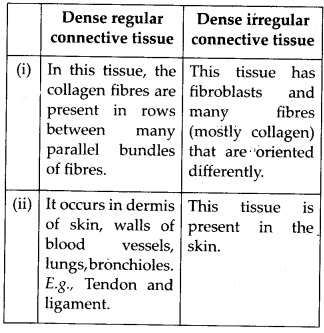
(d) Differences between adipose tissue and blood tissue are
as follows: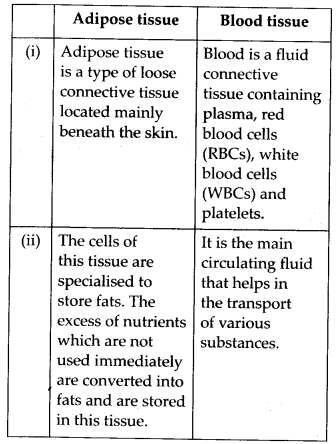
(e) Differences between simple gland and compound gland are
as follows: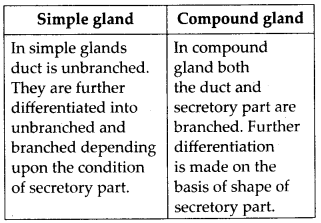
13. Draw a neat diagram of
digestive system of frog.
Solution: 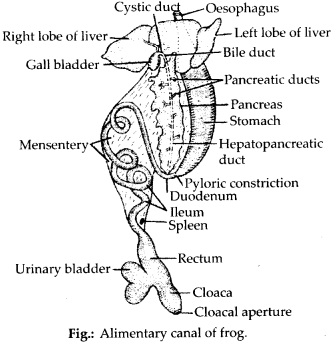
14. Mention the function of
the following:
(a) Ureters in
frog
(b)
Malpighian tubules
(c) Body wall in
earthworm.
Solution:
(a)
Ureters in frog: Ureter is a transparent duct which arise from outer portion of
kidney. In the “male frogs, ureter acts as urinogenital duct which runs
backwards from kidneys and opens into the cloaca. It carries both urine and
spermatozoa from kidney to the cloaca. In female, ureter conducts only urine
from kidneys to the cloaca.
(b) Malpighian tubules: Malpighian tubules are
excretory organs present in cockroach. These are present at junction of mid gut
and hindgut. These are fine, long, unbranched, yellowish and blind tubules and
are 100-150 in number. They help in the removal of excretory products from
haemolymph.
(c) Body wall in earthworm: It consists of cuticle, epidermis,
muscular layer and parietal peritoneum.
(i) It maintains the characteristic
shape of’ the body.
(ii) It protects the internal organs.
(iii) The
cuticle prevents excessive evaporation.
(iv) It serves as an ideal
respiratory organ.
(v) The receptor cells play a vital sensory function.
(vi) The albumen helps in the formation of cocoon. It also serves as a food for
the developing earthworm inside the cocoon.
(vii) Setae and muscles are
responsible for locomotion.
(viii) Excretory matter is passed out through
nephridiopores.